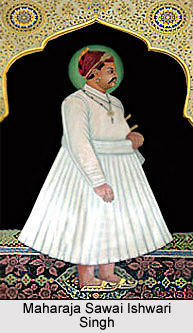Maharaja Sawai Ishwari Singh, a Kachwaha ruler of Jaipur, ruled his dynasty from 1743 to 1750. Maharaja Sawai Ishwari Singh was born in 1721 as the eldest son of Sawai Jai Singh II. Sawai Ishwari Singh`s father wanted him to rule Jaipur after him, thus he got deeds of loyalty signed by his closest generals and kinsmen. Thakur of Jhalai, Raoraja of Sikar and Uniara, and Zorawar Singh of Nindar signed one such deed on January 3, 1742. Rawal Mohan Singh of Chomu also put his signature in this deed. He declared Ishwari Singh the "Crown Prince". Ishwari Singh was crowned the king after Sawai Jai Singh II. But the Maharana of Mewar did not sustain this and perhaps the marriage of Sisodiya Princess was with the condition that her son would be the upcoming Kachwaha ruler.
 Internal disputes grew up between Maharaja Sawai Ishwari Singh and Madhosingh I and the dispute later developed into war. However, Ishwari Singh defeated Madhosingh I in 1745 with the help of Malhar Rao Holkar and Ranoji Scindia. But after the death of Ranoji, his son Jayappa Scindia was with Maharaja Sawai Ishwari Singh and Malhar Rao Holkar stayed with Madho Singh. Again in 1747 Madho Singh was defeated and the Marathas used to collect chauth and sardeshmukhi taxes that counted upto almost 35% of state income, for their support and services. Because Scindia and Holkar were against each other, the Maharana of Mewar called on the Peshwa to interfere. The Peshwa arrived in person, and at Niwai it was believed that Madho Singh has to be given four Parganas. However Maharaja Sawai Ishwari Singh was not present at this settlement and he started suspecting the goals of the Marathas.
Internal disputes grew up between Maharaja Sawai Ishwari Singh and Madhosingh I and the dispute later developed into war. However, Ishwari Singh defeated Madhosingh I in 1745 with the help of Malhar Rao Holkar and Ranoji Scindia. But after the death of Ranoji, his son Jayappa Scindia was with Maharaja Sawai Ishwari Singh and Malhar Rao Holkar stayed with Madho Singh. Again in 1747 Madho Singh was defeated and the Marathas used to collect chauth and sardeshmukhi taxes that counted upto almost 35% of state income, for their support and services. Because Scindia and Holkar were against each other, the Maharana of Mewar called on the Peshwa to interfere. The Peshwa arrived in person, and at Niwai it was believed that Madho Singh has to be given four Parganas. However Maharaja Sawai Ishwari Singh was not present at this settlement and he started suspecting the goals of the Marathas.
The Peshwa returned in June 1748 and after his return Maharaja Sawai Ishwari Singh did not fulfill the settlement. Again in 1750 Maratha army came to Jaipur to recover their taxes and Holker and Scindia was to receive Rs. 200000/- from Maharaja Sawai Ishwari Singh. But this was beyond the capacity of Ishwari Singh and he could not pay the amount and committed suicide on December 12, 1750, by taking poison and bitten with a "Cobra". Next day 20 of Maharaja Sawai Ishwari Singh`s wives died. Madho Singh was crowned as the king but the subjects of Jaipur was so infuriated with this incident that on January 20,1751 all gates of Jaipur were closed down and Marathas were killed inside the city. Almost three thousand Marathas died and 1000 injured. However, the Scindia and Holker were away in "Doab" and later Jayappa Scindia was murdered in Nagaur. In his short tenure Ishwari Singh constructed the "Isar lat" or "Sargasuli"(Tower to Heaven) in Tripolia Bazar of Jaipur.






